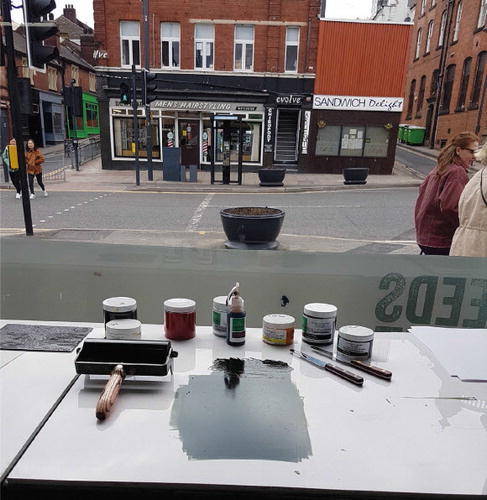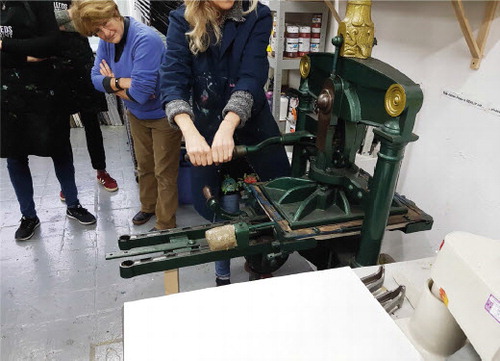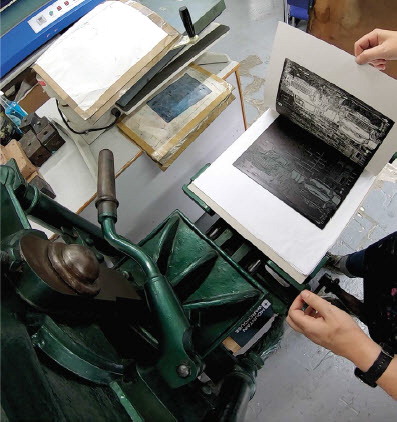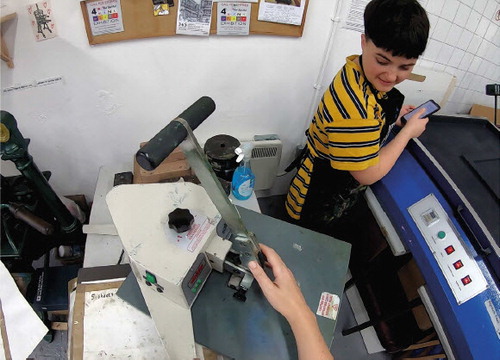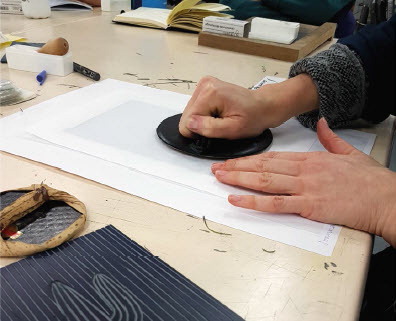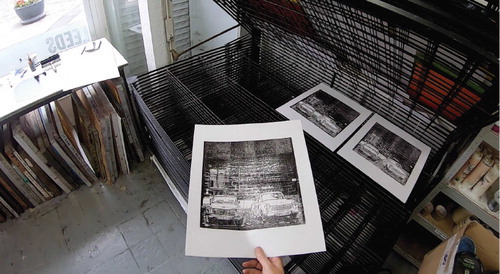Abstract
What is involved in the transition from using a printmaking studio as a participant on a course, alongside other learners, to using the space on a drop-in basis, where there is no longer any instruction save the occasional steering hand of the print technician?
The open access community printmaking studio is considered as a site of amateur practice, where novices and experienced practitioners navigate communal space while undertaking their own work. In contrast with the home workshop, here, not only are facilities shared, with all the negotiations and considerations this might entail, but the successes and failures of individual work are also effectively performed in full view of other users. How might one move from novice to amateur status, and what are the risks involved?
This article draws on ethnographic research undertaken in community making spaces as well as in the home, in which an embedded, embodied approach has been employed to consider the experience of making alone and alongside others.
FIRST STEPS IN PRINTMAKING
‘The reveal’ is the moment in printmaking when the inked surface has made contact with the paper or textile, the pressure has been applied, the press is rolled back and we first see the result. This might involve lifting up a screen, a blanket, a plate or simply the paper itself, depending on the process. In a communal space, and particularly where resources such as a printing press are shared, this is a public moment. The moment is a spectacle: Will the print have worked? Or is a disaster about to be uncovered?
I first try lino printing on a five-week Introduction to Printmaking course at Leeds Print Workshop, a printmaking cooperative that has been running since October 2016, occupying a repurposed space at the edge of Leeds city centre. Its big windows face the street, and from time to time curious passers-by peer in; anyone working at a table by the window unwittingly performs for this audience (). This can be particularly daunting for the novice.
The space aims to be a social space in which to ‘hang out’, with cups of tea, eclectic music choices and a light touch approach to member activity that relies on trusting one another to use the space responsibly, whatever each member’s prior knowledge or experience.
I am one of ten participants learning four types of printmaking: drypoint, monoprint, collagraph and, over two weeks, reduction lino printing. Some of the group are complete beginners while others might be refreshing skills or adapting knowledge from elsewhere; in my case, previous printmaking experience dates back to an art school education twenty years previously. Each session follows a format of spending half an hour watching Joanna, the instructor, as she demonstrates a technique to the group (). We then try the technique ourselves for an hour and a half, queuing for the two presses and peering at one another’s work.
The process for creating lino prints during this course involves marking an image on the rubbery grey linoleum then gouging the surface using sharp tools. A layer of ink is rolled onto the lino surface, which will remain on uncut areas and transfer to the paper. The moment when the printmaker knows whether the image has worked is when it has been through the press, the cover or blanket covering the paper is lifted and the paper is peeled back to reveal the image, transferred from the lino. Unlike in the rehearsal room where the performers can see how the work is developing, until this point the intended image is concealed, whether through its gouged presentation on the un-inked surface, or because it is inverted (in order to appear correctly when pressed against the paper) ().
Even if the image appears broadly as intended when I make the print, I discover other problems: crumbs of cut-away lino accidentally left on the surface to bloom like unintended stars in the middle of a rich black area; lingering traces of wax transfer that stain the print surface with a hard- to-ignore yellow; not enough ink on the surface of the lino, so that the inked areas on the paper are speckled instead of solid. The image thus remains slightly obscured, and each of these issues is a mistake to resolve next time, which might lead to a further mistake to resolve subsequently. This repeated process of trial and error leads me to wonder whether I will ever fully shrug off the feeling of being a novice.
After the course, and despite my enthusiasm for the process, it takes me four months to muster up the guts to commit to creating a lino cut in private and then entering the space as an independent user, ready to print as an amateur with assumed levels of competency instead of the novice I was on the course. I want to be assured and confident with the processes, but I feel that I can only do this by doing the processes, in the space. I have brought my notes with me from the introductory course, and find myself reciting the steps I must take under my breath. Will I make a mistake that exposes my status as a beginner? Will my print, currently untested, look terrible? Or will I make some error when cleaning up? Shared resources require shared responsibility, even though this obligation is more implicit than explicit in this particular space.
Working in the space necessitates constant awareness of the visibility of both processes and outcomes. The technicians, on hand to help out, are all competent printmakers, but, nevertheless, when at one point a technician looks over the lid of the press at the point of the reveal, I am immediately placed in a position of having an audience to whom I must perform (). I note that, ‘I feel self-conscious, like I must justify my novice status.’
Later, when mixing grey ink for a print, I find myself feeling that I’m performing competence, pretending that I am adept at this. From my field notes I observe that I have two palette knives, one for the white ink and one for the black, and with a sort of slow-motion horror I observe myself dipping the black-stained knife into the white ink. I think I emit a very small squeak. Quickly, before anyone notices – not that anyone will notice – I work with a clean palette knife to remove as much of the black as possible. I get most, but not all, of it out. I feel like a complete beginner.
When working round the central table, on the course, it is all too easy to look across at others’ successes when one is struggling to grasp a technique, or to want to conceal a mistake. For the novice this visibility can be daunting, as if performing for an audience without enough rehearsal, despite others’ immersion in their own work, whether cutting, inking or using a ‘baren’ to print in situ without a press (). When I’m using the space independently, however, this sense of exposure is only heightened; despite my inexperience, I now present as an amateur ‘user’ rather than as a novice ‘learner’, and must somehow inhabit this new mask.
PERFORMING THE PROCESS
In reflecting on my experiences I draw on Banfield’s (2017) useful distinction between novices, amateurs (and experts). She suggests that while the novice is learning how to behave within a particular field, the amateur is more established and is therefore able to test and develop capabilities. As I observe myself, at one remove, dipping the black-smeared palette knife into the white ink, this self-consciousness at being somehow caught out in an act forces me to step back from the position of competence to a position of uncertainty; Goffman (Citation1959) describes a disruption of the performance of identity at moments of error, and here, despite my best efforts, I am exposing my status as novice, striving to become amateur.
The embodied experience can be considered as being ‘performed’, as in Ingold’s (2014) notion of performing a series of actions in ‘following the materials’. However, Crouch (Citation2003) considers performativity in a sense of extending oneself, ‘going further’ and embracing openness to possibility, and it is in this sense that I move within the printmaking workshop, embracing a process of ‘becoming’ – in this instance, endeavouring to acquire sufficient skills to be able to position myself as a member of this printmaking community, which requires me not only to establish and consolidate new skills but also to extend myself into the performance of a shifting identity as I move from course participant to independent user.
I have not yet assimilated what I can see before me with more tacit knowledge about the actions I must perform (Bachelard Citation1971 cited in O’Connor Citation2007), so I must rely on what O’Connor describes as ‘mimicry’, improvising as I strive to present myself as competent; the knowledge has not yet been assimilated bodily and so I cannot easily feel, for instance, the exact volume of ‘packing’ papers required to ensure that the printing press delivers the right amount of pressure, resulting in a satisfying ‘reveal’ of the image. I must instead feel my way by drawing on other competences and prior experiences. Banfield (Citation2017) expresses this as a fluidity in which positions of ‘novice’, ‘amateur’ and ‘expert’ are not fixed but can shift according to each new situation; as an example, while in the print workshop I might choose to share an insight that has been developed outside the printmaking context, for instance drawing on prior photographic knowledge to discuss the composition of an image, and thus in this moment overriding my tentative position as a new user of the space. When I stain the white ink, I am able to draw on solutions developed through previous oil painting experience, and though I stumble, I can continue without having been ‘caught out’ or fully revealed; however, when I cannot achieve sufficient pressure in a press, I must seek help and thus cannot avoid exposing my inexperience. At these moments I focus on my novice status and choose to overlook others’ perceptions of my competence, in much the same way that an actor’s keenly felt stage fright could be invisible to their audience.
This account offers an insight into some of the risks and opportunities involved in ‘making visible’ in the shared printmaking studio. The novice printmaker must submit, in Ingold’s terms, to the nuances of the particular printmaking process in order to develop skills and achieve the prints they hope for. However, there are also vulnerabilities unique to working in an open access printmaking studio: communal creative spaces, with shared resources and participant camaraderie, can require the emerging amateur to risk exposure, and potential derailment, at a fragile stage in their development. Jackson (Citation2013) describes the workshop space as a site of potential, offering various ‘affordances’ (Gibson, Citation1979) to the maker, through the facilities, space and what he refers to as ‘project time’. I consider that the open workshop also acts as a performance space; even when the printmaker has left the space, the work continues to act as a proxy while it dries in the communal racks, on display to others, independent from – yet inevitably imbued with – the performance of its creation (). Through continued submission to practice within the space, my position can become more assured; there is opportunity for deeper and more embodied engagement with both the processes and content of the work, and with the space itself, and in doing so I can begin to move away more conclusively from ‘novice’ and towards the more confident terrain of Banfield’s engaged ‘amateur’. However, the uncertainties contained within the moment of the reveal mean that it may remain as a point of tension, regardless of the accumulation of experience.
ACKNOWLEDGEMENT
This research has been funded by the AHRC through the White Rose College of the Arts & Humanities.
REFERENCES
- Bachelard, Gaston (1971) On Poetic Imagination and Reverie, Woodstock, Connecticut: Spring Publications.
- Banfield, Janet (2017) ‘Amateur, professional and proto- practices: A contribution to “the proficiency debate”‘, Area 49(2): 130–6. doi: 10.1111/area.12294
- Crouch, David (2003) ‘Spacing, performing and becoming: Tangles in the mundane’, Environment and Planning A 35(11): 1945–60. doi: 10.1068/a3585
- Gibson, James J. (1979) The Ecological Approach to Visual Perception, 1st edn, Boston: Houghton Mifflin.
- Goffman, Erving (1959) The Presentation of Self in Everyday Life, 1st edn, London: Penguin.
- Ingold, Tim (2014) ‘The creativity of undergoing’, Pragmatics & Cognition 22(1): 124–39. doi: 10.1075/pc.22.1.07ing
- Jackson, Andrew (2013) ‘Understanding the home workshop: Project space, project time, and material interaction’, Interiors 4(2): 175–94. doi: 10.2752/204191213X13693260150380
- O’Connor, Erin (2007) ‘Embodied knowledge in glassblowing: The experience of meaning and the struggle towards proficiency’, Sociological Review 55(s1): 126–41. doi: 10.1111/j.1467-954X.2007.00697.x

